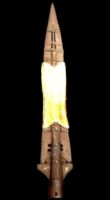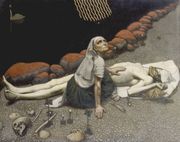The final version of John’s gospel is generally taken to be later than the three synoptics. There are additions in it that can be taken as ecumenical with the European religions. The main detail that we will look at today has correspondences with Germanic and Celtic religions, although not with other Mediterranean religions.
John 19:33 But when they came to Jesus, and saw that he was dead already, they brake not his legs:
19:34 But one of the soldiers with a spear pierced his side, and forthwith came there out blood and water.
19:35 And he that saw it bare record, and his record is true: and he knoweth that he saith true, that ye might believe.
A) By adding the spear, the crucifixion of Jesus resembles those of Esus and particularly Odin. Esus had been popularized among educated Romans by Lucan’s epic poem Pharsalia in the +60s. The religion of the northern Teutons and Germans was at this time more the Vanir fertility religion rather than the Odinistic warrior religion. However the Odinists may have started on their migration from Anatolia to Russia to Scandinavia by the +first century as reported in Snorri Sturluson, popularized by Manly P. Hall and as semi-confirmed in Thor Heyerdahl’s last project before he died. Some think that the references to ‘Mercury’ in Tactitus’ Germania (circa +98) are references to Odin. However Snorri Sturluson is late (13th century), but what matters is that during the Christianization of the northern lands, the Crucifixion of Jesus and that of Odin were compared.
B) The spear itself has a fascinating afterlife appearing in the Grail legends, and being possessed by Adolf Hitler until he was defeated. However, like mos t Christian relics, there are multiple spears.
t Christian relics, there are multiple spears.
C) John does not name the soldier with the spear, but in the Acts of Pilate (4th century maybe) the soldier is said to be a centurion named Longinus. This may be based on the Greek word for spear: ‘longke’. The name of course appeals to those (see Gary Courtney and Francesco Carotta) who see the gospels as rewrites of the hagiography of Julius Caesar for Gaius Cassius Longinus was a major plotter in the Julian Passion. In Dante’s Inferno, Cassius Longinus along with Marcus Junius Brutus and Judas Iscariot are the only persons deemed sinful enough to be chewed in the three mouths of Satan.
D) Improbably, for an occupying army, the centurion Longinus was also said to be blind.
There are several parallels of blind executioners
- Baldr was the second son of Odin, the All-father. After he dreamed of his death, the gods made every object vow never to harm Baldr, but they overlooked the lowly mistletoe. Loki, the trickster, made a spear from mistletoe and took it to where the gods played their new game of throwing things at Baldr who was never harmed. He gave it to the blind god Hodr, Baldr’s brother, who threw it and inadvertently killed. This is the first event leading up to Ragnorak, and after the destruction of the old gods, a resurrected Baldr will inaugurate a new age.
- The Christian saint Alban was condemned to be beheaded, and as the deed was done his executioner became blind.
- In the Ulster tale of Fergus and Medb, they are fornicating in the lake to the chagrin of King Ailill, Medb’s husband. Ailill persuaded the blind spear-thrower Lugaid – who has never missed his aim – to throw in the direction of Fergus.

- Lemminkäinen, the hero of the Finnish epic the Kelevala, is shot by a blind herdsman, and ends up piecemeal until his mother, like Isis with Osiris, puts the body back together, and resurrects it.
- Our conceptualization of Justice sees her as blindfolded and with a sword.
- The Swiss town Sursee in canton Lucerne has an annual festival of Gansabhauet (=beheading the goose) where executioners drawn by lot are blindfolded and attack a dead goose.
As I said, John 19,34 is amazingly ecumenical.
___________________________________________________________________________________________________
Trevor Ravenscroft. The Spear of Destiny. Spearman 1972.
Manly P Hall. The Secret Teachings of All Ages: readers Edition. Tarcher/Penguin 2003 (originally 1928). p64-6.
J.C.J. Metford. Dictionary of Christian Lore and Legend. Thames and Hudson. 1983. See “Longinus, St”
John Grigsby. Warriors of the Wasteland: A Quest for the Sacrificial Cult behind the Grail Legends. Watkins Publishing. 2003 p 41.
Jaan Puhvel. Comparative Mythology. The Johns Hopkins University Press. 1987. p214.
On “Longinus” as “lance”: you’re mixing up the lectio difficilior and the lectio facilior, which means that “Longinus” (the name) came first, and that the name later enforced the centurion to hold a lance. Not the other way around: Longinus wasn’t called “Longinus” because he was holding a lance. That’s nonsense.
Comment by Mary Jane — 10 January 2008 @ 22:34 |
Then explain how the lance in in John’s gospel, but the name Longinus is not.
Comment by markandmore — 11 January 2008 @ 10:55 |
Well, that was the original argument. The “longke” in John is the lectio facilior, but the general rule of text criticism states that the more difficult reading, the lectio difficilior, is the stronger, i.e. original one (http://en.wikipedia.org/wiki/Lectio_difficilior_potior). Since the lance is a standard weapon, a normal “tool of warfare”, it is the simpler and therefore later reading. Everyone knew a “lance”. The fact that the Gospel of Nicodemus was written later than John is no proof that the name “Longinus” was based on “longke” in John. The Gospel of John was subject to a larger amount of réécriture, simply because it was canonical. Therefore — shown by simple philological arguments — the common lance replaced the uncommon cognomen. One could of course end the argument here, but it would be good to look a bit further in order to corroborate the case: the name “Longinus” is very prominent in Christian legends and martyriological accounts, and the Christian Saint is still called “Longinus”, which would be a bit strange, if the name stemmed from only one gospel — and a rather late and apocryphal gospel at that too. (However the original scripture could have been much older than the 4th century, but it is not clear, if the testimonies, e.g. by Justin the Martyr, are actually relating to these specific “Acts of Pilate”.) Futher evidence is found in the earliest depiction of the crucifixion in a narrative context, the ivory casket in the London Museum (http://www.usask.ca/antiquities/Collection/Death_Judas_1.JPG), where Longinus on the right is holding not a lance but is applying a dagger thrust. Interesting is also that he doesn’t wear the usual military attire, which he became famous for in later centuries, but civilian clothes, especially a toga-like garment, and a pileus, the cap of Roman freedmen. Futher evidence is found with John himself, in Rev 1.7, where it says that the Christ was “pierced” by “them”. However the primary meaning of “èxekénthsan” here is “stabbed”, confirmed by the Vulgate, which reads “pupugerunt”, coming from “pugio” for “dagger”. In addition, blood seeps from the wound of Christ on the cross. So to give a more “naturalistic” interpretation, the crucifixion could have been a standard Roman crucifixion, without nails and with the Christ being tied to the cross (or rather pole: “stauros”) to die a long death of starvation, but he was pierced (stabbed) by at least the one centurion called Longinus, with a dagger, to put him out of his misery or to “finish him off”, so to speak. (This is however just a wild conjecture, unlike the rest of what I wrote.)
Comment by Mary Jane — 14 January 2008 @ 11:51 |
The lectio difficilior rule applies to copies of the same manuscript, to work done by copying minions. Neither you nor the Wikipedia article make the further quantum leap that would be required to apply it to writers of new gospels, who may consider both options, and more, and choose the one that makes their point.
I was intrigued by your presentation of Longinus stabbing Jesus with a dagger, or in Latin a sicar, which makes him a sicarius (a word that was later corrupted into ‘ iscariot’). Prior to the gospel of Nicodemus, Longinus is found in the Roman historians. That is, Gaius Cassius Longinus, assassin of the other J.C. (Julius Caesar). By analogy, his stabbing is transfered to the Jewish J.C.
I don’t understand your cross-reference to Revelations. Surely you don’t think that the same ‘John’ wrote both the gospel and Revelations. To start with, the style is very different.
Comment by markandmore — 15 January 2008 @ 16:50 |
No, of course the “John” of Revelations is not the “John” of the Gospel of John. There is not even any such thing as a guy called “John”. 😉 It was a scriptural redaction, many writers, copyists, possibly supervisors etc. But anyway, it was about the fact that Revelation clearly states that Jesus was stabbed with daggers by a group of people (“they”). (But maybe this is referring to the attack on Jesus, as he was captured…)
The “lectio difficilior potior” not only applies to copies of the same manuscript, but also to a collection of narratives that tell the same story, and this is what we’re dealing with here. All the Gospels tell the same story, although in different versions and with different approaches. But there is one specific narrative (especially the passion account), and therefore a single origin behind the accounts of the life of Jesus. So if one account calls the centurio “Longinus”, and the other calls the same person “lance-man”, it’s clear that these are two variants of the same name, and that the latter is the “lectio facilior” and therefore the later version after réécriture. The copyist/writer/evangelist substituted the name “Longinus”, which not everybody knew, with a tool that everyone knows, the lance. But a “lance-man” can’t become a “Longinus”… the direction is always from the special toward the common. It was definitely a choice for making a point, but not the choice between “Longinus” and “lance-man”, but only the choice to discard the original cognomen in order to be able to make *better point*.
On the “other Longinus”, Cassius Longinus: his coin, the one minted by his fellow assassin Marcus Brutus, shows his and Brutus’ dagger plus the cap of the freedmen, because they saw themselves as liberators of Rome: http://www.the-romans.co.uk/gallery3/bigimages/14.ides_of_march.jpg It’s the same cap that the “Christian Longinus” is wearing on the ivory casket. Some say the ivory casket is the first depiction of the crucifixion ever… I don’t know about that… but it’s definitely the first one in a narrative context, with the chronology being depicted from right to left. Therefore we have 1) Longinus’ dagger thrust, 2) Christ on the cross, 3) the mourning of the people and 4) the suicide of the traitor. It’s interesting that the dagger thrust comes first. Interesting is also that in later iconography, especially since the Renaissance, Longinus moved to the left of the cross in most cases (if I’m not mistaken), with the vinegar sponge being offered mostly from the right. (But I don’t know if this has any relevance.)
Although I’ve read it often, I’m not sure if “sicarius” (as “Sikarios”? — or even from a Latin source as “sicarius”) was actually transposed into “Iskariot”, though it might have rubbed off on the epithet and might have enforced the emergence of “Iskariot” from whatever his true name really was. But if the Cassius Longinus from the Caesarian Histories actually served as a role-model for the centurio Longinus (whether by analogy or by direct transposition), which means that the evangelists knew the Caesar sources, then (for “Iskariot”) one could as well assume the Roman Isauricus, who was one of Caesar’s 12 disciples. 🙂
Comment by Mary Jane — 17 January 2008 @ 17:42 |